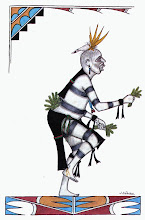The Sun Dance: Sacrifice, Integration, Reciprocity, and Regeneration
A very important consideration in understanding the Native American’s perception is that the buffalo is a highly social animal, naturally sociable. That is a trait with which the Plains people could identify, finding similarities to the broad allegiances and communal relationships characteristic of their own social organization. Unlike more solitary species, the buffalo, as a herd animal, is often referred to by the natives as a “tribe” or “nation.” The movements and whereabouts of that “buffalo nation” influenced the Lakota tribal structure and location at a given season. Generally, the Lakota’s interactions with buffaloes do not involve personal contact with individual animals, but rather the whole species or population. Calling the animal “Buffalo” always implies reference to the group or at least a member who represents that group. One specific buffalo is rarely, if ever, singled out or named as is often the case in many societies with any animal who is to be eaten. This practice helps in combating the revulsion that may accompany the consumption of flesh from a familiar individual being. The communal ritual reconciliation is made with the species as a whole: human society appeases the buffalo nation.
Helping to relieve the guilt resulting from killing and eating conscious creatures, too, is the persistent belief that animals willingly offer themselves to hunters. This idea is reflected in the observation that “the Lakota spoke of their hunt not as ‘driving’ the buffalo but as ‘leading them’; not ‘chasing,’ but ‘calling’” them. Certain men possessed “the power of charming the buffalo into a corral or over a cliff.” They accomplished this feat by disguising themselves in buffalo robes and imitating the animals’ movements and sounds. The conviction that the buffalo voluntarily give themselves to be killed for the benefit of human beings is closely associated with Plains people’s sense of identification with the animal and with the force of reciprocal obligations toward it. As expressed by members of one tribe, “Since buffalo allowed themselves to be used in order that the Lakota people could live, it seemed fitting . . . to offer a part of themselves to the sun and other spiritual persons.”
Therefore the sacrifice of the dancers through fasting, thirst, and self-inflicted pain reflects the desire to return something of themselves to nature, with special reference to the life- sustaining buffalo, in exchange for past and future benefits. Elements of the Lakota sun dance are almost certainly derived, features the self-torture of participants by means of buffalo skulls.
Additionally, men disguised as other animals including grizzly bears, eagles, antelopes, swans, rattlesnakes, beavers, vultures, and wolves, imitated the sounds and behaviors of their respective species. The players enacted interrelationships involving struggle between various forms of life. Animals growled and chased each other and meat-feeding scenarios took place. This performance represents the expression of a theme dealing with predator-prey relationships. Evidently, the ambiguities of carnivorous behavior were being explored through ritual. To a greater or lesser degree depending upon the tribe, the sun dance includes the elements of sacrifice and pain on the part of participants. The ultimate gift is the offering of one’s own body. In a deep sense, this phenomenon of undergoing physical agony relates the supplicants to the rest of nature; it is atonement in the true meaning of “at oneness,” with reference to the unity of the cosmos. For all living creatures are subject to suffering and share a common capacity for pain. According to Oglala tradition, “This truth of the oneness of all things we understand a little better by participating in this rite, and by offering ourselves as a sacrifice” Death, represented by undergoing torture, signifies that the profane man has been killed and the participant has come to life regenerated in body and soul. The person must “die” through the ordeal of “being cut to pieces” in order to bring about his symbolic resurrection. The meaning of the cutting and bleeding of the Lakota dancer who is pierced, the pain that results is “the natural complement of his figurative death.” The flesh that is tom away when the thong breaks loose “represents ignorance,” which “should always be behind us as we face the light of truth which is before us.” Therefore the sun dancer is reborn, mentally and spiritually as well as physically, along with the renewal of the buffalo and the entire universe.
The great sun dance ritual establishes the tenet that there is no final death, for all living things can be renewed. Human beings, however, like all their fellow creatures, must cooperate in order to bring about universal regeneration. By feeding grass to the buffalo skull, the cycle of life is symbolically perpetuated. To appease the buffalo who gives so much to people, appreciation and good intentions must be shown, and deferential behavior is mandated. By significant acts like refraining from eating buffalo flesh after the animal has provided a vision, leaving some of the meat to make peace with the animal’s spirit after a buffalo is slain, and planting a piece of sacred buffalo tongue back into the ground during the ceremonial feast, honor is given to the spiritual presence of the buffalo. Because the animal’s spirit still remains when the buffalo is killed, death is not final; eternal return is assured for both buffalo and humankind through reciprocal actions that maintain the harmony of the natural world. So at the close of the Oglala sun dance, Wakan-Tanka is addressed: “You have taught us our relationship with all … beings, and for this we give thanks… May we be continually aware of this relationship which exists between the four-leggeds, the two-leggeds, and the wingeds. May we all rejoice and live in peace!”

No comments:
Post a Comment